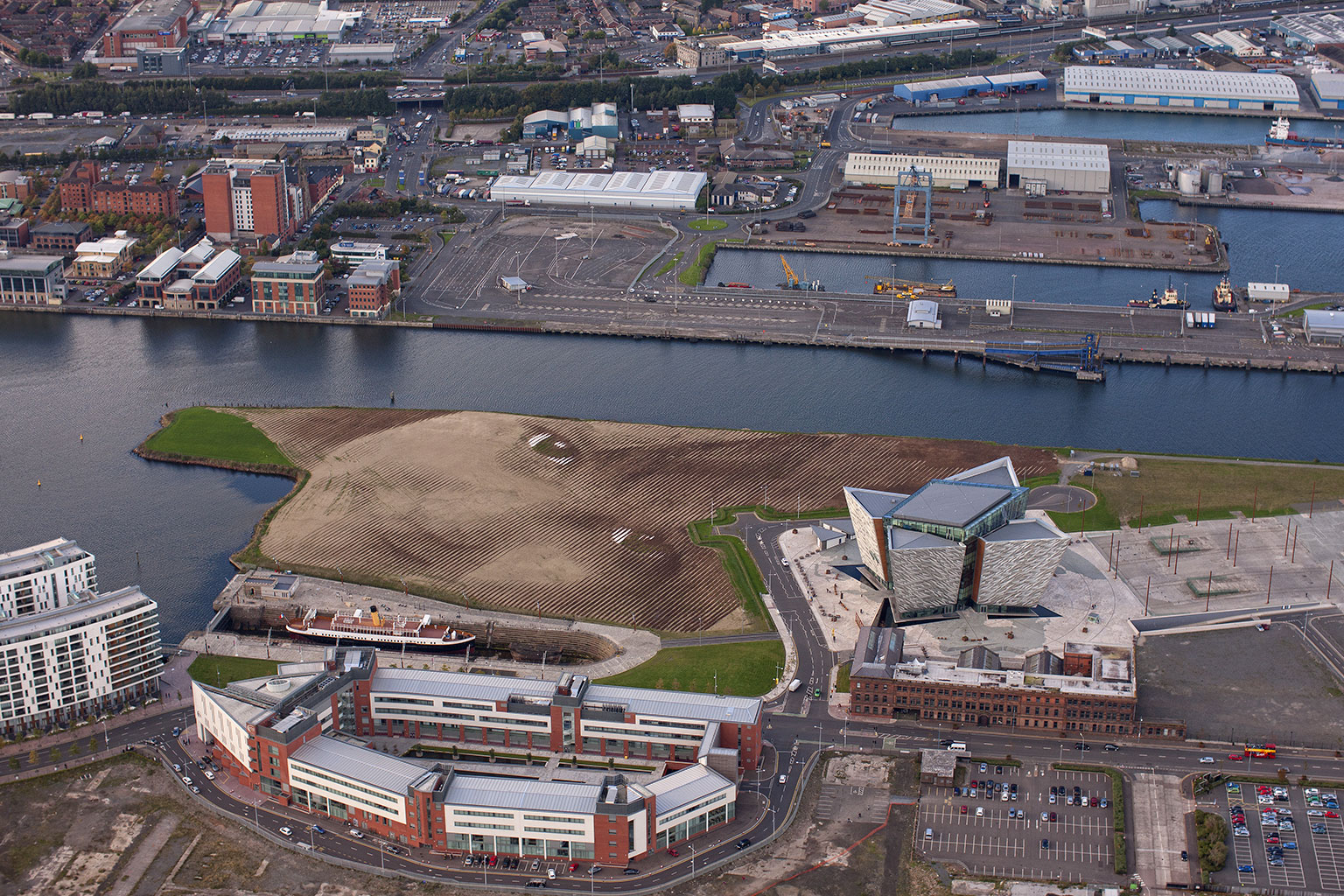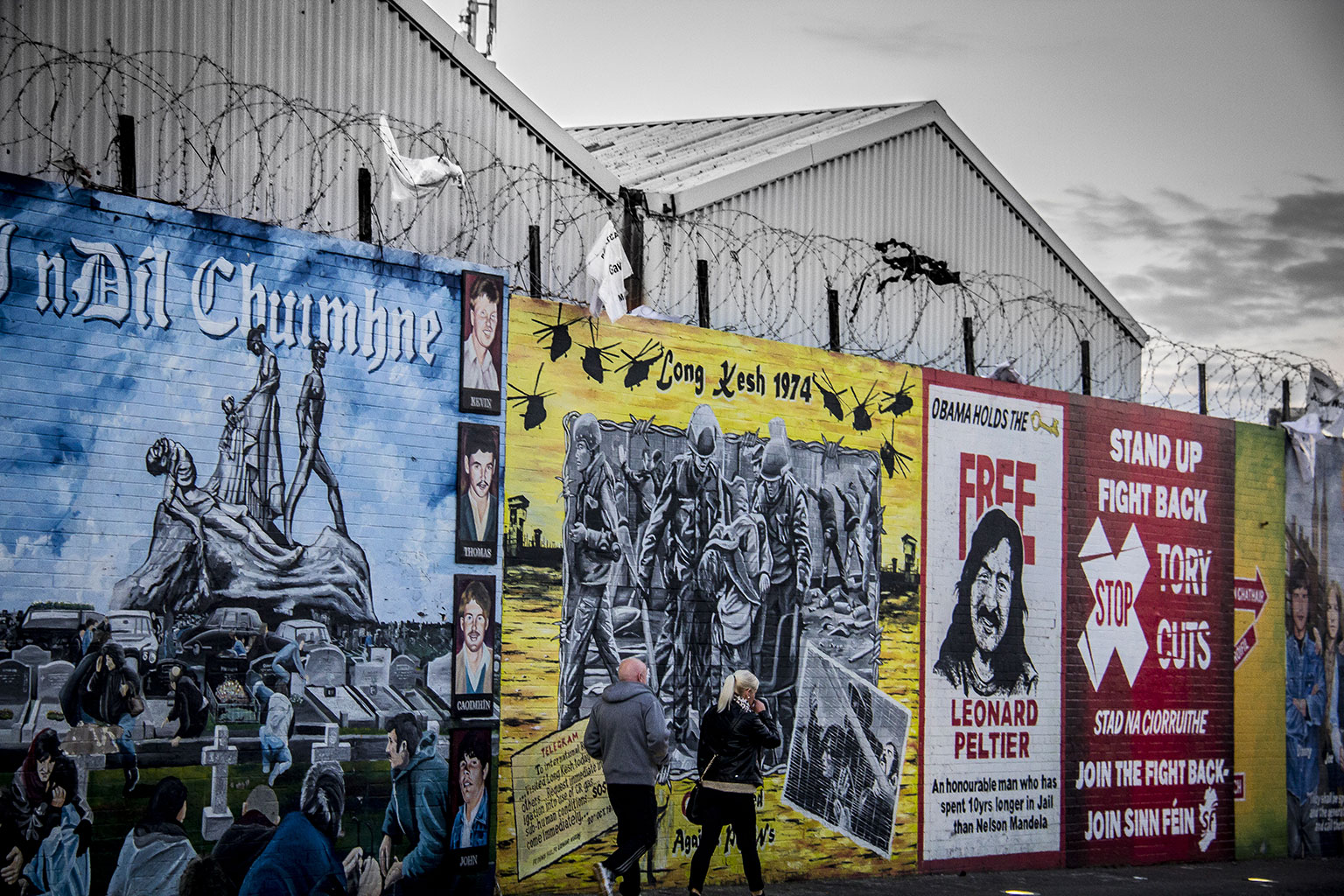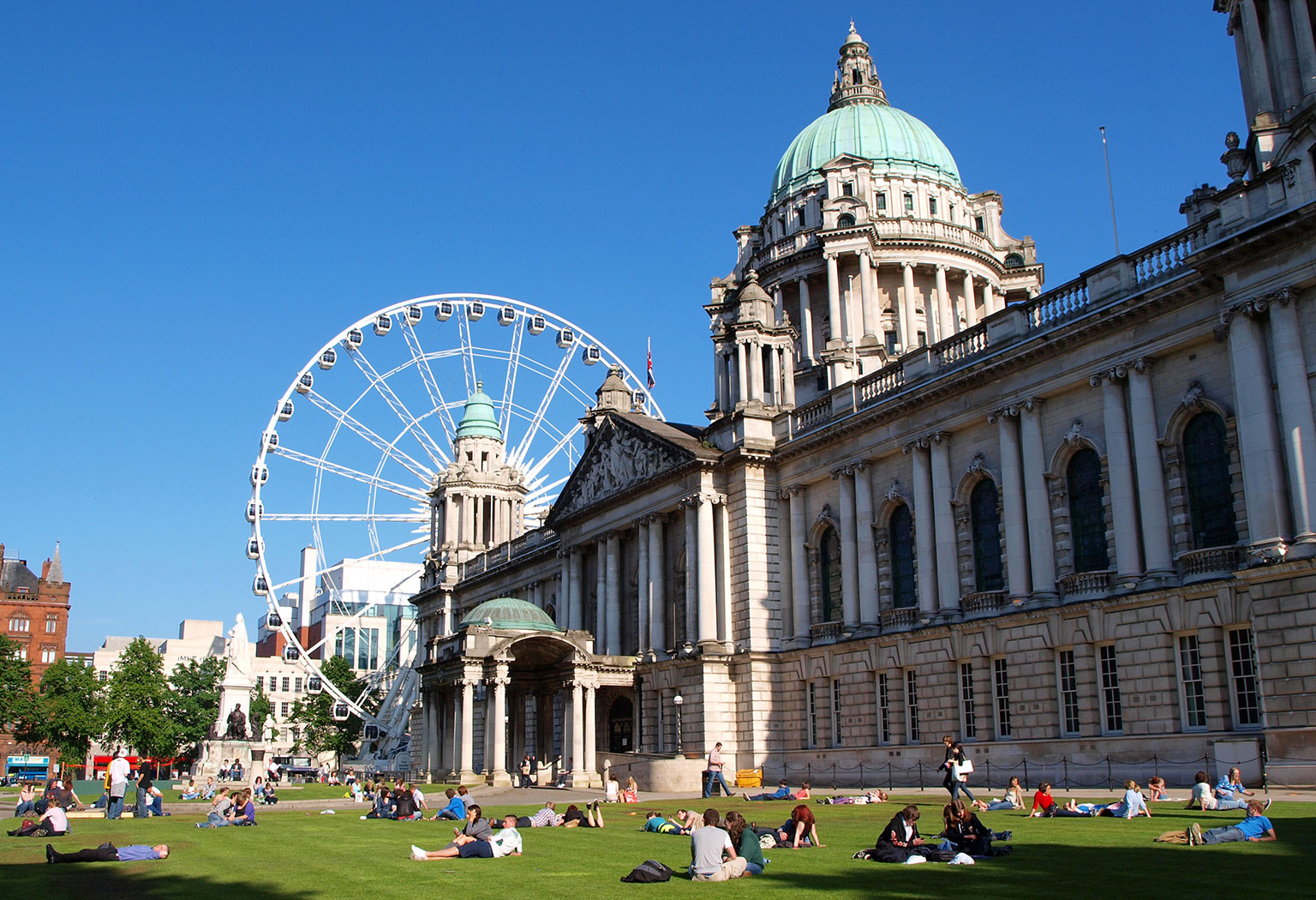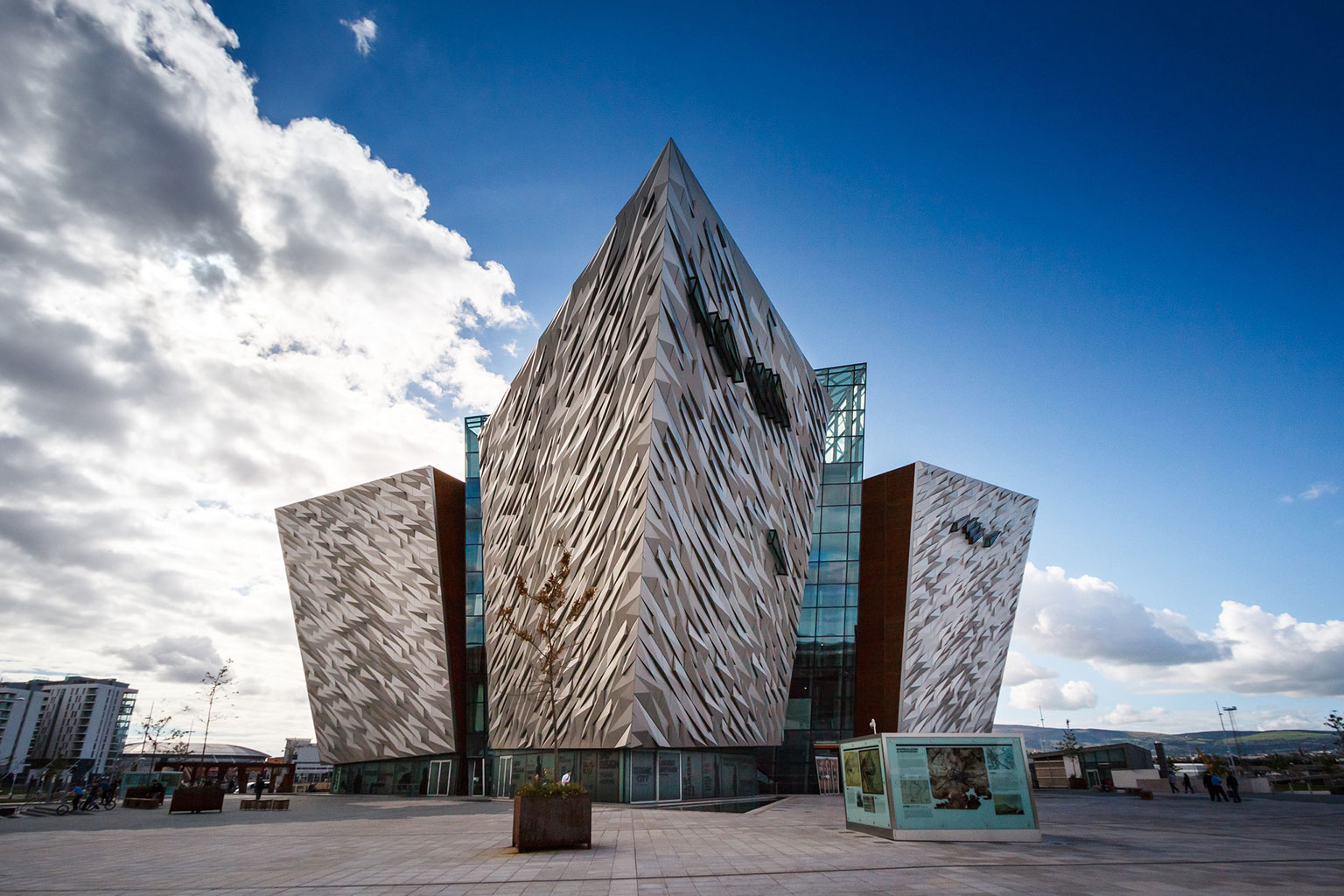My first meeting with Belfast’s chief executive is in a London hotel. A man in a hurry, about to retire in six months. He wants a plan for his city centre. He knows nothing about city planning, he explains, so he’s phoned around a few people—in Manchester, Liverpool, and elsewhere—and the name of our Toronto firm keeps popping up. There will have to be some kind of formal selection process. But will we do it?
The reason he claims (disingenuously) to know nothing about planning is really where this Belfast story starts. Early in the Troubles, as the more than three decades of deadly sectarian strife in Northern Ireland are known, Belfast had all its planning, housing, and regeneration powers removed by the British government. The city council, then dominated by Protestant unionists, had discriminated against the Catholic minority, restricting access to jobs, housing, and community facilities. Through the 1970s and 1980s, the vicious conflict continued, with much of the violence concentrated in the close, working-class neighbourhoods that surround the city centre. In the 1990s, a struggling momentum toward peace finally culminated in the Good Friday Agreement, which, through elaborate power-sharing structures, finally returned democratic government to the country from British trusteeship. One of those accords dealt with giving back appropriate city management powers to Belfast City Council. That process has taken a while, but is now about to happen.
And so: can he have a plan, please. And fast.
Our firm specialises in planning downtowns, waterfronts, and urban projects around the world. This would, however, be the first time we’d work in a major city with no dense layering of previous plans, bylaws, regulations, and guidelines, none of the great pile of relevant and irrelevant paper that typically stares blankly at us at the start of every job.
“It’s really quite simple,” the chief executive explains. “Tell me the five things I should do in the city centre, tell me why, and tell me how.”
Who could ask for a better brief?
Yet I notice during our breakfast—he has requested a private room for the meeting—that every time a server enters, he and his colleague fall silent. And then they start up again after the visitor leaves. I sense that this might not be an ordinary job.

First impressions are important in my line of work. To remember what you see and feel, the sense of the place, the buzz—or lack thereof—during your first visit. The buildings, the streets, the trees and parks. The people: taxi drivers, hotel clerks, restaurant servers. The colour, the sound, the smell. A city has only one chance to make that impression. Afterwards, you know too much. All the reasons why, and why not. So imagine yourself a tourist, an investor, an immigrant, a job seeker, a kid from the sticks—what kind of place is this? Are you going to like it? Is it beautiful (even if it’s ugly)? Does it work? Does it leave you curious for more?
So I always write it down. Here, from my notes, is Belfast:
A grand and handsome city, an imperial city, a city of the Empire, like Liverpool, Glasgow, and Cardiff—a capital city, although it’s not quite clear of what. Its bones are Victorian; a magnificently extravagant neo-classical city hall right at the centre, with shining white limestone turrets and pergolas. Surrounded by a grid of fine buildings. Great green hills lean in from either side. Giant yellow shipbuilding cranes with oil rigs under construction mark the way to the sea. In the low spring evening light, the city softens. There’s a bustle around the centre, but it fades quickly to the north, where the city gets harder, emptier, vacant. Nothing worse than many other northern UK and European cities, but empty lots, too much asphalt, not enough trees. The river, the city’s reason for being, is a place apart, edged by a last round of waterfront development but lacking any visual or activity interest.
It’s a compact centre, that’s good; you can walk across it in fifteen minutes, but a detached centre, separated from the surrounding residential areas by a ring of expressways, rail tracks, and the river. Still, it’s in much better shape than I had expected. Good money has been spent on fine streetscaping and a couple of key buildings, an interesting arts centre and a well-executed in-city shopping centre—a difficult urban trick to pull off. New office buildings—very good sign—but on the edge, not in the middle.
It’s clean, no litter. The extensive stock of heritage buildings has been well-maintained. But the active centre is too small for the city it is. Retail looks to be in trouble, with too many vacancies where there shouldn’t be. There’s a hip district, the Cathedral Quarter, but the bars and restaurants are rattling around after nine at night. If anybody lives here, it isn’t obvious; the few recent apartment buildings stare dead-eyed at the river. Everyone who works here seems to be gone by 5 p.m. Not enough life, liveliness, people, cars, residents, shoppers, workers, tourists. Not enough buzz. Not enough green. Not enough business.
We’ll have to see what we can do about that.
This is not a typical city centre. For almost thirty years, most was located inside a “ring of steel” security fence, and everyone entering was subject to an airport-style security search. Not the best way to build customer loyalty. Indeed, given the active retail competition from out-of-town centres and the alternative business locations available, it’s a huge achievement that there’s an attractive and functioning city centre at all.
The recession hit Northern Ireland hard, worse than mainland UK. Less than an hour to the south, the Irish Republic, the north’s biggest trading partner, suffered a massive business-, banking-, and property-sector collapse. House values have still to regain their pre-recession levels on both sides of the border. But things are looking up. Every week, a new 50-, 100-, or 200-employee knowledge-industry business relocation or expansion is announced. There is a critical shortage of office space. Just the kind of problem we like to have. But the unemployment rate remains well over the UK national average. And so every possible new job for the region is coaxed and coddled with a host of generous and sophisticated incentives. Peace in the province is highly dependent on prosperity.
Two years ago, Titanic Belfast opened—a major tourist attraction featuring historical and interactive exhibits on the site where the famous ocean liner was constructed. Its success has given a big boost to the city’s confidence. Belfast has become a place that people from outside Northern Ireland are visiting. And there are other encouraging signs. Good food is a reliable leading indicator of future city success, and a definite scene is developing in the centre.
There’s a great market, recently voted the best in Britain, with a range of mass and artisanal producers. It’s my kind of food, from stormy seas and rainy ground. Well-hung beef and lamb, fresh fish, root vegetables, dark greens. Full-flavoured beer, solid bread. Cheese with a serious back story. Duck, pheasant, rabbit, venison, eels. Food that has worked for a living. Stews, roasts, grills, pottage. I’m getting to like this place.
One of the consequences of the Troubles is that the neighbourhoods surrounding Belfast’s city centre, which used to be quite mixed, have become more uni-sectarian, with Catholics and Protestants fenced into their own districts. Literally fenced in: at the worst of the violence, “peace walls” segregated the neighbourhoods into unitary communities; they are still there—just in case.
Imagine a fifteen-metre-high chain-link fence in Toronto, between College and Dundas Streets, separating the Italians and the Portuguese, each enclave decorated with vast murals depicting the saints and martyrs of their cause. Imagine each of Toronto’s ethnic groups fenced into their own areas. That’s the geography of inner-city Belfast, except here they’re religious, not ethnic. A total of about thirty kilometres of fencing still exist, winding their way around each sectarian pocket (although, for several years now, as tensions have abated, the gates through them have been opened).
These old sectarian neighbourhoods were home to those most affected by the collapse of Belfast’s traditional shipbuilding, engineering, and linen-mill industries. Although the industries disappeared thirty years ago or more, the culture of real work being “working with your hands” and a disdain for education persists, particularly in the Protestant communities. (Discrimination against Catholics, ironically, tended to force them to upgrade their skills.) In stark contrast to the rest of Belfast, only 3 percent of the children in the worst areas go on to further education after leaving high school. A hard nut of the under-educated, unemployed, and unemployable exists in all comparable northern European cities—but they can get up to a lot more trouble in Northern Ireland.
It’s becoming clear that any plan for this city will need to be about people and their prospects, not just physical projects. And so a working relationship is established early on with the University of Ulster, which is in the process of moving its large main campus into the northern part of the centre, becoming probably the most effective instrument of change for the entire area. Educational and institutional connections to surrounding neighbourhoods can challenge the culture of worklessness and raise aspiration and ambition in stranded youth.

We meet again to manage the project in the chief executive’s grand office in Belfast’s city hall, complete with its huge windows, fireplace, and marble columns. On his wall, on the mantelpiece, and on the shelves is the dense clutter of memorabilia seemingly universal in all municipal leaders’ offices. Except that this one includes a personal note from Barack and Michelle Obama, a signed poem from Seamus Heaney. Bill and Hillary have left some trinkets. What’s going on? Why does a damp, mid-sized city on the northeast coast of Ireland merit such attention?
Through the decades of the Troubles, over 3,500 people were killed, tens of thousands were injured. To give a sense of scale, two people were killed in Quebec during the contemporaneous FLQ crisis—the only time in Canada’s recent history when troops were sent into the streets to “apprehend an insurrection.” Had that conflict unfolded proportionately by population as it did in Northern Ireland, over 10,000 would be dead, and 100,000 wounded. Thank God for the good sense of Quebecers.
Everyone in Northern Ireland has a very close, bitter, and personal experience of the Troubles. But Northern Ireland for the past two decades has been in search of peace, something requiring impressive, relentless citizenship and generosity at both a personal and a political level. For these were mostly “neighbourly murders,” in Heaney’s chilling phrase. That’s why their halting but increasingly steady steps toward peace must be successful. That’s why presidents and poets leave their messages to all involved. There are distinctions of dress, dialect, and demeanour between the feuding communities, but they take years of close study to spot. On first meeting, they all look like average white folk to me. If the better angels of their nature cannot triumph, where can they in a world riven by much deeper divisions?
It’s easy to get carried away. Northern Ireland is well-acquainted with the well-intentioned. A friend recounts being part of a recent delegation of Toronto non-profit foundations, in Belfast earnestly instructing the feuding parties on our long tradition of “getting along.” “Have you ever killed a man? ” asked one of the hard faces around the table. The delegation didn’t know how to respond. My son, who knows Belfast, phones me up to offer advice: “Remember dad, you’re just a plumber, not the Dalai Lama.”
So plumbing, planning. What do we actually do?
We arrange meetings with everyone we can—city officials, agencies, developers, arts groups, retailers, lobbyists, community leaders, activists, and editors. People with ideas, interests, obsessions. We inhale Belfast, hour after hour. It’s fascinating. Wonderful, richly imaginative, deeply committed people who love their city. This may be the north, but it is Ireland after all; words rush at us like white water. We try not to form any conclusions, just ask questions and listen. Let people have their say, give them the time they need to tell us what they feel we really need to know.
The trick to being a good city planner, as with a happy marriage, is to be just a bit deaf. At least half of what we hear from these kinds of meetings is nonsense. The skill is knowing which half.
We walk every block, at all times of day and night, to fix the feel of the city under our feet. Slowly, walking and talking, the city tells us about itself.
And then there are the facts. Markets, costs, demographics, economics. These awkward things are what distinguish real urban planning from activist advocacy. Not all things are possible. There are choices.

The first presentation of our initial directions is held in the “emergency room,” a large boardroom full of chalkboards, telephones, and monitors, with a few secure rooms to the side. Happily, it has not had to deal with many recent emergencies, although sometimes violent clashes persist over symbolic issues—such as how many days per year the Union Jack can fly over city hall, and the routes of loyalist parade marches. Absurd to an outsider, but tenaciously resistant to resolution.
Our committee consists of the leaders of the six political parties on city council. (The ranked balloting system designed to give all a voice has produced a plethora of political groups, all in a city the size of London, Ontario.) Most of the councillors look like municipal politicians the world over—slightly rumpled, slightly harried. A couple are very different; big men, with polished scalps and trim goatees, who have history in the Troubles. They settle into the room. The republican starts to josh the unionist. “Was in East Belfast [the unionist stronghold] last week. Ya murals now, they’re not up to scratch. Getting formulaic.” The unionist lowers his jaw. “Right you are. The quality, the human touch, it’s not there anymore. It’s the computer design that does it. No feeling in it.” They both shake their heads at the digital decay of the creative spark. We proceed to discuss parks and public art. Peace through urban design.
Another route to peace and reconciliation in Belfast, however unlikely it may seem to Canadian ears, is ice hockey. The Belfast Giants deliberately set out to be a non-sectarian team, banning particular national anthems, colours, flags, and even soccer shirts of teams such as Glasgow Rangers, Celtic, Liverpool, or Everton, who draw affiliation from Protestants or Catholics respectively. So they have a large and enthusiastic non-sectarian fan base largely made up (again, to a degree unfathomable in Canada) of teenage girls.
The Giants have been a great success, with the help of a strong share of former NHL’ers. Good Canadian names from a few years back. Theo Fleury spent some time here, along with Jason Bowen, Paul Kruse, Jason Ruff, and Paxton Schulte, all making a comfortable late-career living.
All I hear are lovely Canadian accents back and forth from bench to coach. There are huge advantages to our nationality, if largely because of who we are not. Not English with attitude, Irish with baggage, Europeans with effortless certainty, Americans with assertive know-nothingness. Being nice is also a very effective business strategy. We get along. Blessed are the peacemakers wearing skates.
It would be hard to conceive of two cities more different than Belfast and Toronto. One old world, one new; one grand, one utilitarian; one barely ticking over, one growing like topsy. And of course, one tribal, the other the epitome of post-tribe. Belfast is 96 percent white—forget about Catholic-Protestant, that’s the critical urban statistic. And yet it’s important to remember that Toronto itself was once the largest Orange town in the world. (Wikipedia asserts that every mayor of Toronto since its founding was an Orangeman until Nathan Philips, a wonderful Jewish mayor, was elected in 1954.) Even the current mayor, John Tory, draws his name from a bunch of brigands and royalist cattle thieves in the Irish backcountry.
Toronto’s Orange Lodge has now all but faded away. But the Protestants left a strong trace in our city’s DNA. An unostentatious blandness, an enduring politeness, a pleasing reserve, a distrust of beauty, a personal generosity, a distaste for show. A relentless localism, a pride in community, a love of domesticity, a reticence regarding sex. Peace, order, and government—and don’t get too big for yourself. “A good place to mind your own business,” as Northrop Frye captured it.
One of the fascinating aspects of Toronto is the way these traits are passed on to new generations as they arrive from all over the world. There is nothing so permanent as character, in cities as in people. I recently took my granddaughter to the finals of Toronto’s middle school volleyball competition at Duke of Connaught School, in the middle of Leslieville, a gentrifying inner-east district. About a third of the girls wore headdresses, about a third were white, the rest everything under the sun. All of them whip-smart, fit, polite, and smiling. Duke of Connaught, Earl Haig, Earl Grey, Lord Lansdowne; the Ulster aristocracy rests eternal in the Toronto school system. Is that how our distinct cultural character endures, transmitted through those named bricks and mortar?
Back in Belfast, the new plan begins to take shape. We suggest strategies for new office and housing districts, for reversing the retail slide, and for a general softening and greening of the city. The street system can be calmed and simplified, and the river, cut off to the east, brought back into the heart of the city. Strong connections are defined to tie troubled surrounding districts into the success of the core, along with a major new park to knit the university into the centre. There’s general acceptance of where we’re going. It all seems a bit too easy.
And then Gerry Adams, the leader of Sinn Féin, is arrested and held for four days of questioning in connection with a particularly hideous terrorist murder that happened early in the Troubles. The ground shakes. Republicans condemn dark political forces. Up yours, say the Unionists. Positions harden.
Peace in Northern Ireland, or rather the lack of conflict, depends upon a large measure of what Tony Blair and Bill Clinton, chief architects of the 1998 settlement, characterised as “creative ambiguity.” So many terrible things were done by all involved. Is justice best served by relentless investigation of past wrongs, or by determinedly looking forward? Tough, tough questions.
But suddenly it’s over. Adams is released without charge.

The city organizes a big public presentation event for our final report. They want everyone in the room. Cities that have something bold to do cannot be led just by their formal governments—they need a much broader constituency, the larger body politic, the “great and the good” as they are known in the UK; the business, arts, academic and political sectors, the key community leaders, the movers and shakers. I saw it happen in Manchester after the devastating 1996 bombing that wrecked that city centre. New York mayors Rudy Guiliani and Michael Bloomberg both convened similar “estates general” after 9/11 and the Wall Street crash. Something similar occurred in Toronto after the SARS crisis, when the Summit Alliance (now known as CivicAction), convened by the redoubtable David Pecaut, forced a bold agenda of action on a hapless city council. Belfast is lucky because, unlike much larger cities, it can assemble all key stakeholders under one reasonably sized roof. It’s a huge advantage, to be able to forge the broad consensus essential to move a big agenda forward.
Before going public, the review committee in Belfast wants a last look at things. There’s a lot of pressure to suggest more social housing as a part of the mix. It’s a standard call for politicians and community leaders, all the more in a divided city where control over housing still means control over votes. They think I want to fill the city centre with yuppies. They could be right.
It’s one of those times when it helps to be from away. Belfast absolutely does not need more affordable housing. This is not Toronto or any other booming Canadian city. It already has the cheapest housing in the UK, and the worst neighbourhoods are emptying out as residents vote with their feet. You can buy a terrace house for $100,000. It certainly doesn’t need more poor people, with concentrations of some of the lowest incomes and highest unemployment in the country. It needs more people with some money in the bank, more wealth, more jobs. It needs more economic activity. If we can attract more well-paid knowledge workers to live, work, shop, eat, and have fun in the centre, and can spread those opportunities to the surrounding neighbourhoods, that will be success. “Just more trickle-down nonsense” say the housing activists. Well, trickle-up doesn’t seem to work. You need to have something to redistribute.
This debate, between a city as an agent of wealth creation or as a promoter of wealth redistribution, has gone global. It is particularly acute in Europe, where the combination of slow recovery from the recession and frail public finances has put into question the very affordability and effectiveness of the extensive safety net of income and housing support programmes characteristic of social democracies. It also is increasingly clear that the contemporary urban economy is inherently “spiky,” to use Richard Florida’s apt adjective: it differentially rewards the talented and abandons the unskilled, so you can have economic growth or you can have income equality. What seems hard is to have both, in a world where it is cities, as much as countries or companies, that are in competition. Negotiating this left-right debate—a debate that has been obscured for decades in Belfast by the sectarian divide—may have to become the city’s new political culture.
Through all the consultation, I slowly pick up distinctions between the factions, if only in body type; the republicans run to string beans, the loyalists to fire plugs. And then their presence; the nationalists have a dangerous charm, overconfident that history and poetry are on their side. The unionists, sure of right and might, have a stubborn fortitude—with a hint of Rob Ford. Utter stereotypes of course, but two-thirds true. Both sides share grievance as a comfortable default mode; they have deep wells of resentment on which to draw. At one point, we do a word count to make sure we have the same number of “wests” and “easts” in the final report.
But I like these people; even the tension has an endearing side, the complete opposite of Toronto’s often passive-aggressive style. In a Belfast meeting, the participants’ verbal agility will sucker punch you quick between the eyes—but then they give you a hug and buy you a Guinness.
I’m a plumber, not the Dalai Lama. But I do know good plumbing helps, good planning makes a better city. Nothing in city planning ever happens fast—as six months stretches to a year, there are a few political wobbles. A fifth urban “quarter” has to be added to the original four in our plan. So be it; not the time to get precious about math. It’s Belfast’s plan now, not mine. An energetic female chief executive takes over, one of a fine tribe of strong-shouldered Northern Irish women steadily replacing the embattled males. That has to be progress.
The better angels finally take wing. The plan is unanimously adopted by council. For further consultation of course. But Belfast has its future city to agree on.
History says, Don’t hope
On this side of the grave,
But then, once in a lifetime
The longed-for tidal wave
Of justice can rise up
And hope and history rhyme.—The Cure at Troy by Seamus Heaney


